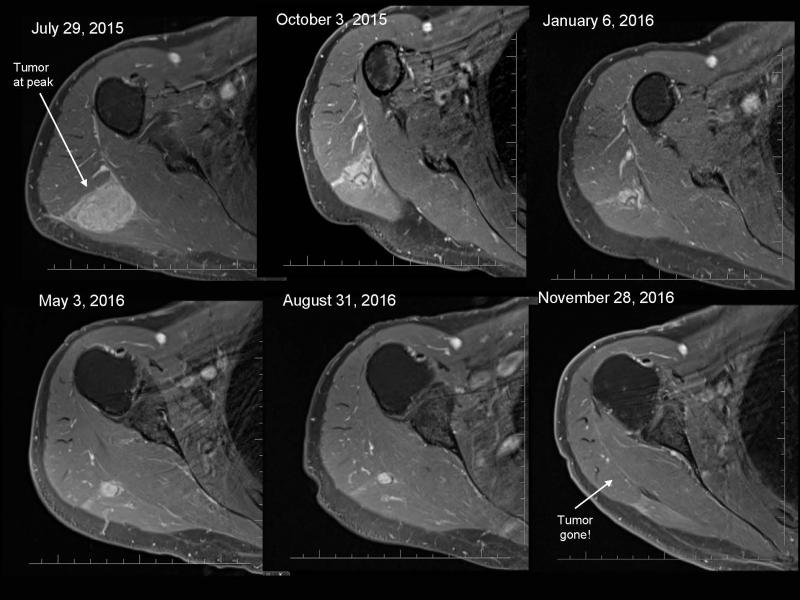The Power of Combination Therapies: One Patient’s Road to Remission
28 February 2017 | Science, Treatment

Metastatic melanoma can be a devastating diagnosis to receive. Just hearing the word cancer for most is terrifying. While the fear is understandable, today new targeted therapies and immunotherapies are delivering new hope for many. Despite new hope, early detection and prevention remain critical to yielding the best possible health outcomes for all.
According to the American Cancer Society, individuals with stage IV malignant melanoma face a 5- year survival ranging from 15 to 20%. For patients receiving PD-1 immunotherapy, research has shown 5-year survival rates of up to 34%. While survival rates are improving, the overall low rates across the board can often provoke feelings of anger, fear, and disappointment amongst recipients of such life-altering news. These are all feelings that David Rohler, PhD experienced upon receiving his initial diagnosis.
A vibrant 70 year old scientist, Rohler initially presented to a dermatologist for a skin check after noticing a changing mole on his scalp, in conjunction with swelling of the neck. The mole was biopsied, and his sentinel lymph node was found to be positive for melanoma. Radical surgery was performed to remove his tumor and lymph nodes in the neck, followed by radiation therapy post-surgery. Based on the full workup, a diagnosis of stage IV, metastatic melanoma was made.
Unfortunately, his initial surgery was not curative, and Rohler experienced a number of subsequent metastatic tumors located on his liver, brain, shoulder, and chest wall. He endured countless surgeries and radiation treatments in hopes of overcoming his disease, yet sadly, new tumors continued to develop. Only after being placed on immunotherapy did Rohler’s disease begin to respond favorably.
Immunotherapy has significantly transformed the disease trajectory for a number of patients with late-stage melanoma. Checkpoint inhibitors such as anti-CTLA-4 and anti-PD-1 immunomodulatory agents can help to ensure the patient’s immune system is able to do its job in attacking tumors. Clinical trials are currently underway to investigate the efficacy and side effect profile of these agents in combination, and compared against each other, regarding overall patient survival. Early results are showing improved survival rates, but also some serious and concerning side effects affect some patients.
For Rohler, a combination approach proved highly effective. He was placed on an initial course of ipilimumab (anti-CTLA-4) followed by a yearlong course of nivolumab (anti-PD-1). Now disease free, Rohler recalls experiencing a number of side effects during his yearlong stint with immunotherapy, including extreme leg-pains, excessive fatigue, increased creatinine, and skin rashes. His treatment course was certainly not without difficulties, but 6 months post therapy, he remains disease free.
While immunotherapies, particularly when used in combination, are showing improved survival rates, the vast majority of melanoma patients still do not live to see five years of survival. Early detection and prevention remain key strategies to avoid the fear of a stage IV diagnosis and the associated low-survival rates.
Routine and systematic skin checks are paramount to early diagnosis of melanoma, particularly in higher risk patients. The 5-year survival of stage I melanoma patients currently ranges from 92-97%, thus, early diagnosis lends itself to significantly improved health outcomes. The drop in survival as the melanoma stage increases further highlights the importance of the dermatologist’s role in performing thorough skin checks. This responsibility extends to primary care physicians, who may have more regular contact with patients, thus should also be performing consistent skin examinations for those at risk. In addition, individuals should be mindful of any changes in their skin and bring them to the doctor’s attention. Heightened skin cancer surveillance, in conjunction with a multidisciplinary medical and surgical approach that continues to evolve with novel immunotherapies, offers tremendous hope to the field of advanced melanoma.
Detection Immunotherapy Combination Therapy tumors metastatic tumors Treatment
